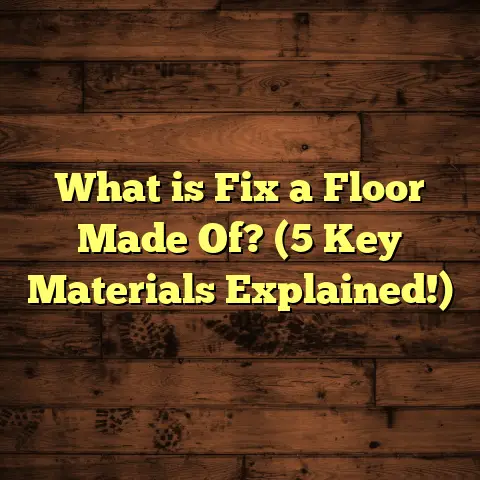What is Wood Floor Refinishing? (5 Steps to Revive Your Floors!)
What is Wood Floor Refinishing?
You know that feeling when you look down at your hardwood floors and realize they don’t shine like they used to? Maybe you’ve got scratches, dull spots, or even some stubborn stains that just won’t go away. If this sounds familiar, you might be wondering: what is wood floor refinishing exactly?
Wood floor refinishing is the process of restoring your existing hardwood floors by sanding off the worn-out top layer and applying fresh finishes to bring back their original beauty. Instead of replacing the entire floor, refinishing allows you to transform what you already have. Think of it like giving your floors a facelift — restoring their character and charm without the hassle and cost of a full replacement.
I’ve worked with countless homeowners who thought their floors were beyond repair, only to see them come back to life after a refinishing project. It’s amazing how much difference a little sanding and finishing can make!
Why Bother Refinishing Your Wood Floors?
Let me ask you this: Why spend time and money on refinishing rather than putting in new flooring? For me, the answer is clear — refinishing saves money, preserves the history of your home, and keeps the eco-friendly factor in check.
Cost Savings
Installing new hardwood floors can run anywhere from $8 to $12 per square foot or more depending on wood species and installation complexity. On the other hand, refinishing typically costs between $3 and $5 per square foot, depending on your area and floor condition. For a 1,000 square foot space, that’s a big difference — potentially thousands saved.
Longevity Extension
Hardwood floors can last over 100 years if maintained properly. When you refinish, you’re removing damage like scratches, dents, and stains while resealing the wood to protect it from future wear. This extends the life of your floors substantially.
Eco-Friendly Choice
By refinishing instead of replacing, you avoid sending old wood to landfills. Plus, you reduce demand for new lumber harvesting. It’s a greener choice that helps conserve natural resources.
Increased Home Value
According to the National Association of Realtors, homes with hardwood floors tend to sell faster and at higher prices. Refinishing keeps your floors looking their best — which can be a strong selling point.
My Personal Journey with Wood Floors
I still remember my first major wood floor refinishing project years ago. The client was skeptical — their floors were scratched, darkened with age, and covered with layers of old finish that had yellowed over time. They were thinking about ripping everything out.
After walking them through the refinishing process and showing examples of previous work, they gave me the green light. The sanding revealed beautiful natural grain beneath those dirty layers. I applied a rich, warm stain and sealed it with a durable finish.
When they saw the final result, they were blown away. Their home instantly felt warmer and more inviting. That project taught me how powerful refinishing can be — not just for aesthetics but for restoring pride in a space.
Understanding the Wood Floor Refinishing Process: Five Key Steps
Refinishing wood floors might sound straightforward at first — sand and finish, right? Well, there’s more to it than that if you want professional results. Here’s how I approach every job:
Step 1: Preparing the Room Thoroughly
Preparation isn’t glamorous but it’s essential for good results. I always start by moving out all furniture and appliances from the room (or section) we’ll be working on. The less clutter, the better.
Next up is cleaning — dirt and grit left on floors can dull sanding blades or cause scratches during sanding. I vacuum thoroughly and mop lightly if needed.
Before sanding, I inspect the floor closely for any nails or staples poking up. These could ruin the sander or cause gouges in the wood. I use a hammer or nail set to countersink nails or remove staples.
If there are squeaky or loose boards, I secure them with screws or wood glue to prevent movement later on.
Another preparation step I don’t skip is sealing off doorways and vents using plastic sheeting and painter’s tape. Sanding creates a ton of dust — sealing off prevents it from spreading throughout the house.
Pro Tip: I always check for pets or small children before sealing off rooms — safety first!
Step 2: Sanding—The Heart of Refinishing
Sanding is where most of the magic happens but it also requires experience and attention to detail.
I start with a heavy-duty drum sander equipped with coarse 36-grit sandpaper for the first pass. This strips away the old finish and smooths out deep scratches and dents.
Then I switch to medium grit (60 or 80) for a second pass to smooth rough spots.
Finally, I use fine grit (100-120) for a finishing pass which leaves the wood ready for staining or sealing.
For edges and corners where large sanders can’t reach, I use an edge sander or hand-sand with sanding blocks.
One thing I’ve learned is that different wood species react differently to sanding. For example:
- Oak sands evenly and is forgiving
- Pine is softer so it needs gentle handling to avoid gouges
- Maple can get blotchy if sanding isn’t consistent
Avoiding “chatter marks” — ripples caused by uneven sanding pressure — requires steady hands and sharp sandpaper. It’s an art!
On average, sanding takes me about 6-8 hours for a typical 500 sq.ft room, including edges.
Step 3: Cleaning Up All Dust Thoroughly
After sanding, dust covers everything like snow. Walls, windowsills, baseboards—dust everywhere!
If you don’t clean this thoroughly before finishing, the dust will get trapped under your stain or polyurethane causing bumps or cloudy spots.
I use industrial shop vacuums designed for fine dust along with tack cloths (sticky cloths used to pick up dust particles) to wipe every inch.
I also wipe down walls and light fixtures near the floor since dust settles everywhere.
Here’s a story: On one job, a homeowner tried skipping this step because they were impatient. We ended up having to redo the finish coat twice due to dust contamination. Not fun — so take your time here!
Step 4: Applying Stain (Optional Step)
This step lets you customize your floors’ look by adding color or enhancing wood grain.
There are tons of stain colors out there — from golden honey tones to rich espresso browns.
When I work with clients on stain choices, I always recommend testing on a small hidden patch first because wood absorbs stains differently based on age and species.
Did you know about 60% of homeowners choose a darker stain than their original wood color? Darker stains tend to hide imperfections but can show scratches more later on.
If you love that natural wood look, you can skip staining altogether and go straight to clear finishing coats.
Applying stain requires care:
- Use quality brushes or cloths
- Apply evenly in thin coats
- Wipe off excess quickly to avoid blotches
- Let dry fully before sealing
Step 5: Sealing Your Floors for Protection
Sealing is what locks in your work and protects floors from moisture, wear, and stains going forward.
The most common sealers are polyurethane finishes available in two types:
- Oil-based: Durable with warm amber glow but longer drying times and stronger odor
- Water-based: Clear finish that dries fast with less odor but slightly less durable
For residential homes, water-based finishes are popular because they’re quick-drying and maintain color clarity over time.
I usually apply three coats of finish with light sanding between coats using very fine sandpaper (220 grit) for smoothness.
The final curing process takes about 5-7 days before heavy furniture can be placed back down without causing dents or marks.
Diving Deeper: Data & Research on Wood Floor Refinishing
I like backing up my work with data because it helps set realistic expectations for clients.
Here are some interesting stats from industry sources:
- According to The National Wood Flooring Association (NWFA), hardwood flooring has an average lifespan of 40-100 years depending on species and maintenance.
- Refinishing can typically be done every 7-10 years depending on wear.
- A survey by HomeAdvisor found that 70% of homeowners who refinish floors report increased home value.
- Properly refinished floors reduce allergens by eliminating cracks where dust can accumulate.
- Water-based finishes have become 30% more popular than oil-based in recent years due to environmental concerns and ease of use.
- Average project times from prep to finish range from 3-5 days depending on room size.
Common Challenges & How I Overcome Them
Refinishing isn’t always smooth sailing. Here are some recurring challenges I’ve encountered:
Problem: Deep Gouges or Water Damage
If your floor has deep gouges or water stains that penetrate beyond the surface layer, sanding alone might not fix it fully.
In cases like these, I sometimes recommend spot repairs using wood filler or even replacing small damaged boards before sanding the entire floor.
Problem: Uneven Floorboards or Squeaks
Floors installed decades ago might have uneven boards that cause squeaks or gaps when walked on.
Before refinishing, I secure loose boards by screwing them down from below or filling gaps with flexible fillers designed for wood movement.
Problem: Blotchy Stain Absorption
Certain woods absorb stain unevenly causing blotchy spots after staining.
To avoid this, I use pre-stain wood conditioners which help even out absorption, especially on softer woods like pine or maple.
Problem: Dust Control
Dust control during sanding can be tough in older homes without modern HVAC systems.
I always recommend using professional-grade vacuums attached to sanders plus sealing off work areas carefully. Air scrubbers also help reduce airborne dust during work.
Case Study: Victorian Home Transformation
One project close to my heart was restoring floors in a Victorian-era home built around 1890. The original oak floors had layers of paint splatters and thick grime from decades of neglect.
The owners wanted modern styling but didn’t want to lose historic character.
After extensive sanding through old paint layers and cleaning every inch, we applied a warm amber stain that highlighted original grain patterns beautifully.
We sealed with an oil-based polyurethane for durability but kept sheen low for authenticity.
The result? Gorgeous floors that honored history while fitting today’s aesthetic perfectly. The owners couldn’t believe we saved what they thought was junk!
Tools & Materials I Use Regularly
For those curious about equipment:
- Sanders: Drum sander for large areas; edge sander for corners
- Sandpaper grits: 36 (coarse), 60/80 (medium), 100/120 (fine), 220 (between finish coats)
- Vacuum & tack cloths: For dust removal
- Stains: Brands like Minwax & Varathane
- Finishes: Bona Traffic HD water-based polyurethane is my go-to lately
- Safety gear: Dust masks/respirators, ear protection
Tips If You’re Thinking About DIY Refinishing
If you’re considering tackling this yourself, here are some pointers:
- Rent quality equipment — cheaper sanders may cause damage
- Practice sanding on scrap wood first
- Don’t rush grit changes — follow proper sequence
- Clean dust thoroughly after sanding
- Test stains on hidden spots
- Follow manufacturer drying times religiously
- Wear proper masks — hardwood dust can irritate lungs
But keep in mind: Even small mistakes can ruin results leading to costly fixes later. Hiring an experienced contractor often saves time and money in the long run.
How Long Does Refinishing Take?
From start to finish, most projects take between 3 to 7 days depending on size:
- Day 1: Prep & move furniture
- Day 2: Sanding entire area
- Day 3: Dust cleanup + stain application (if any)
- Day 4 & 5: Apply multiple coats of finish with drying time between coats
- Day 6+: Curing time before heavy use
You’ll want to avoid walking on freshly finished floors much until fully cured — patience pays off here!
Maintenance Tips After Refinishing
Once your floors are refinished, keeping them looking good is key:
- Use felt pads under furniture legs
- Clean regularly with microfiber mops (avoid wet mopping)
- Wipe spills immediately
- Avoid high heels or pets’ sharp nails causing scratches
- Reapply protective coats every few years as needed
Proper care can extend your floor’s beauty for decades.
Wrapping Up
Wood floor refinishing is an excellent way to restore beauty while saving money and resources. With the right approach — thorough prep, expert sanding, careful finishing — you can revive floors that look worn down into stunning surfaces that feel brand new again.
Every project I do reminds me why hardwood remains such a beloved flooring choice — timeless style combined with durability when cared for properly.
If you’re weighing options for your floors right now, consider refinishing as a smart solution that offers both aesthetic appeal and value preservation.
Got questions about your floors? Want help figuring out if refinishing will work in your space? Just ask! I’m happy to share advice based on years of hands-on experience helping people bring their wooden floors back to life.
Would you like me to help create a step-by-step checklist or guide tailored specifically for your home? Or maybe a cost estimate based on your floor size? Just let me know!





